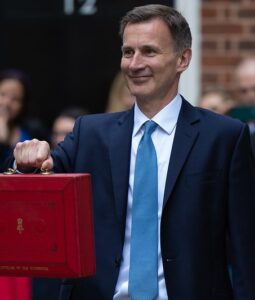UK chancellor Jeremy Hunt used this year’s Autumn Statement to drop a bombshell on the LGPS, hinting that the government wants to significantly reduce the number of local government pools.
 Outlining his key policy priorities for the coming year in the House of Commons, the chancellor said that by 2040 all local government pension fund assets will be invested in pools of £200bn or more.
Outlining his key policy priorities for the coming year in the House of Commons, the chancellor said that by 2040 all local government pension fund assets will be invested in pools of £200bn or more.
The LGPS currently has £364bn in assets, which are invested across eight pools. Even considering asset growth over the next 17 years, Hunt’s statement strongly implies that these assets could be merged into two or three pools.
However, in the official policy documents released with the Autumn Statement, the government merely said that it is “setting a direction towards fewer pools exceeding £50bn of assets under management”.
Nathan Yeowell, chair of the Gwent Pension Fund and Labour Party councillor for Torfaen Council in Wales, highlighted that the push for consolidation could have unintended consequences: “The £200bn threshold for LGPS pools is going to come as a shock to the local government sector – greater scale is welcome but I’m worried that we’re marching towards geographic decoupling at the precise time we should be nurturing more organic links for levelling up capital investment,” he said.
Martin Bailey, vice chair of Lambeth’s LGPS Pension Committee predicted that the push for bigger pools could lead to greater competition among pools: “It is about to get dog-eat-dog out there and only three, maybe four of you can survive,” he warned.
Iain Campbell, senior investment consultant, investment DB at Hymans Robertson, said: “The additional mention in yesterday’s statement, and tucked away in the consultation response, of pools achieving £200bn in size in the future, with some link to a GAD calculation of the LGPS reaching £950bn in size by 2040, brings further uncertainty and confusion. The hint is that there will need to be a second round of consolidation to achieve this figure by 2040, if asset growth projections prove correct.
“Whilst there is potential for greater benefits to be achieved by scale, we again point out the potential diseconomies of scale, particularly of larger pools being able to provide sufficiently for a greater number of funds’ needs and not being able to access smaller scale investment opportunities. Larger pools may not be the best way of delivering further benefits and more work should be done to definitively establish the optimal scale for pools.”
Private equity push
The government is also keen to press ahead with its ambition for the LGPS to dedicate at least 10% of its strategic asset allocation to private equity, in line with the proposals set out in a policy consultation on LGPS Investment earlier this year.
Shifting more public sector pension money into unlisted markets could “unlock” £30bn the government claims, estimating this could free up £25bn in additional cash.
However, industry practitioners say that many LGPS funds already meet the 10% threshold for private equity investment and the reforms would have little impact in practice.
Only a third of LGPS Investors plan to increase their allocation to private equity over the next years, according to a survey conducted by Room151 and Schroders.
Bailey welcomed the aim to invest 10% of LGPS assets in private equity. “With potential to unlock £30bn investment in our fastest growing companies, it’s an excellent ambition,” he said.
Asset consolidation
The government also confirmed it intends to persist with its target to speed up the transfer of local authority pension fund assets into pools. The government’s consultation on LGPS Investment outlined a March 2025 deadline for all listed assets to be pooled.
However, the wording released today is somewhat more ambivalent, and merely states that the government aims for “accelerated consolidation of Local Government Pension Scheme (England and Wales) assets” without specifying if this applies to all listed assets, as initially set out.
Responding to these plans, Nigel Peaple, director Policy & Advocacy at the Pensions and Lifetime Savings Association (PLSA) said: “We are also concerned that the Government is standing by its current rapid timeline for the transfer of assets from pension funds to the asset pools in the LGPS, although it is potentially helpful that this will go forward on a comply or explain basis.”
Philip Pearson, partner and head of LGPS Investment at Hymans Robertson, also acknowledged that the government appears to have taken some criticism on board.
“Whilst the government has taken time to consider the feedback received, noting large concerns put forward for a wide range of the matters, it appears all of the key issues are still being put forward. However, it is pleasing to see some changes will not be enforced, instead either taking the form of “comply or explain” or being voluntary. This includes the ability of funds to explain why certain assets aren’t pooled by the 2025 deadline and government confirming that funds will not be forced to make investments in private equity and levelling up.
“Similarly, there will be no mandating of pool consolidation in the medium term. There are also some sensible concessions on how the single preferred model of pooling will be defined, focusing on characteristics and outcomes, rather than specific structures,” he added.
“LGPS bubble”
A key reason why the LGPS is cautious to increase its allocation to riskier private market assets is the fact that rising gilt yields have significantly improved funding ratios. With more than two thirds of LGPS funds being fully funded, Steve Simkins, partner and public services lead at Isio argued that the LGPS not be seen in isolation from the difficult financial situation of local authorities.
“The Local Government Pension Scheme is currently holding up to £100bn more than it needs to fund its pensions promises. This is a huge extra buffer that has arisen unexpectedly since last year, and which was not planned for.” Simkins stated that at least some of the additional funds should be used to reduce employer contributions, given that the Autumn Statement did not release any additional funding for local authorities.
“It is imprudent for LGPS funds and their actuaries to be too prudent within their bubble – it could cause the whole local government bubble to burst,” he warned.
Fast forward to 2025?
While Hunt’s reform agenda could spell potentially far-reaching changes for the LGPS, there was also a sense that the upcoming general election could throw a spanner into the government’s plans.
A key question now will be if the government can push for further large scale LGPS consolidation without detrimental effects to scheme members, industry sources responded.
One LGPS Pool, Border to Coast, was part of a group of finance industry figures who met with shadow chancellor Rachel Reeves earlier this week to discuss the launch of a new infrastructure investment council.
“We welcome all opportunities to help policymakers establish a strong and sustainable investment ecosystem for assets owners,” the pool said, stressing the non-partisan nature of the discussion.
Mick McAteer, co-director of the Financial Inclusion Centre, criticised both Labour and the Tories for their reliance on private finance to meet economic and policy challenges. He called out both parties for using financial deregulation to provide investment incentives.
McAteer said that the government’s plans for a UK Growth Fund vehicle run by the British Business Bank effectively amounted to a public private partnership aimed at keeping the costs of infrastructure investments off state balance sheets.
“This is a financial conjuring trick and a false economy that will cost households more over the years in the form of higher bills to pay for the return expectations of private finance,” he said.
—————
FREE weekly newsletters
Subscribe to Room151 Newsletters
Follow us on LinkedIn
Follow us here
Monthly Online Treasury Briefing
Sign up here with a .gov.uk email address
Room151 Webinars
Visit the Room151 channel













